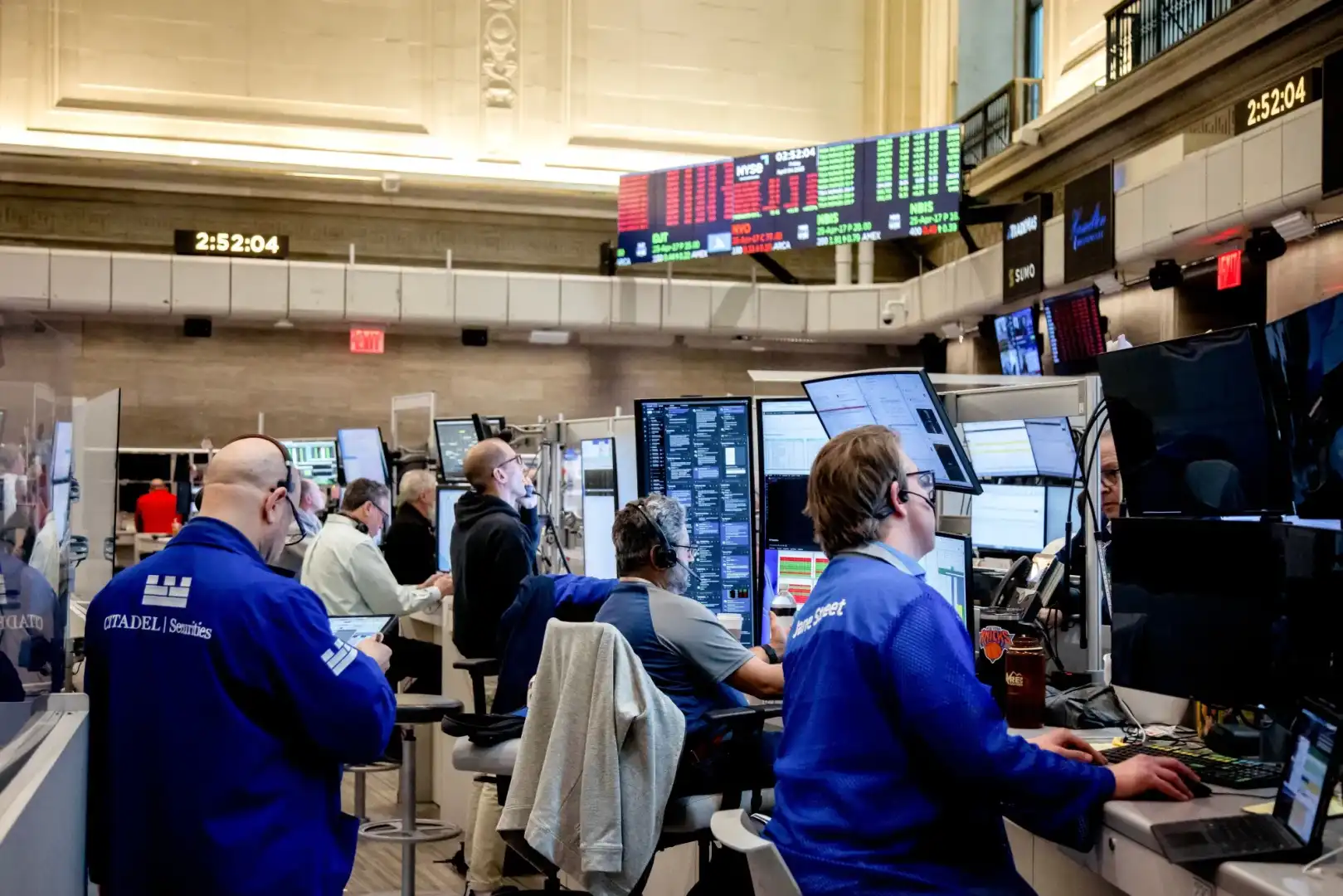In a day marked by extreme volatility and mounting uncertainty, U.S. Treasury investors found themselves reeling from a sharp selloff that sent yields soaring to levels unseen in years. Despite President Donald Trump’s temporary pause on new tariffs—a move intended to ease market pressures—the global bond market remained jittery. In what some analysts called a “forced but orderly” selloff, hedge funds and large institutional investors were compelled to dispose of vast quantities of U.S. government debt in a bid to manage liquidity concerns. As trading continued amid an environment of heightened uncertainty, questions arose about the long-term appeal of U.S. Treasuries as the world’s safe haven asset.
A Day of Unprecedented Turbulence
On Wednesday, the U.S. bond market experienced dramatic fluctuations that brought back memories of previous crises. The selloff, at points reaching levels not seen since 2001, left investors with substantial losses, even as relief appeared briefly in the form of a well-received auction of 10-year Treasury bonds. Despite meeting expectations, the auction did little to ease investor worries about the broader implications of such a volatile market.
Earlier in the day, investors witnessed yields on 10-year Treasury notes jump to a seven-week high—a surge that underscored the fragility of market sentiment. The higher yields, inversely related to bond prices, had a direct effect on borrowing costs across the globe. With rising government debt costs, the broader economy faced increased pressure, ranging from corporate loans to even household mortgages. As central banks around the world remained on high alert, the bond market’s erratic behavior was a stark reminder of how interconnected global finance has become.
The Trump Tariff Pause: A Double-Edged Sword
President Trump’s decision to impose a 90-day pause on most new tariffs appeared initially as a welcome relief to an anxious market. However, his simultaneous move to raise the tariff rate for China to 125% effective immediately muddied the waters. While the temporary pause was hailed as a sign that the U.S. government was willing to step back from aggressive trade measures, it was not enough to restore full confidence among investors. This mixed signal—a calming pause offset by an aggressive stance on China—contributed significantly to the instability witnessed in bond trading.
The political backdrop of this announcement played into broader concerns about the U.S. economy and its global image. Marc Rowan, CEO of Apollo Global Management, publicly expressed his worry about potential long-term damage to the U.S. brand, citing that aggressive and unpredictable policies could undermine the nation’s standing as a reliable economic partner. Financial markets, sensitive to political shifts, picked up on every nuance of the administration’s approach, and the mixed signals resulted in a day of relentless anxiety and rapid-fire trading adjustments.
Forced Selling: Hedge Funds and the Unwinding of Debt-Fueled Bets
One of the most distressing aspects of the day’s trading was the forced selling triggered by hedge funds that had overextended themselves in the Treasury market. These funds, heavily reliant on “basis trades”—a strategy that involves using borrowed money to exploit small differences in prices between the cash and futures markets—found themselves cornered when prime brokers began to tighten margin requirements. In simple terms, these funds had to liquidate portions of their Treasury holdings to meet collateral demands, leading to a cascade of sales that further depressed bond prices.
Mukesh Dave, Chief Investment Officer at Aravali Asset Management in Singapore, captured the sentiment when he stated, “When the prime broker starts tightening the screws in terms of asking for more margins or saying that I can’t lend you more money, then these guys obviously will have to sell.” This cascade was not just an isolated event but part of a broader pattern of liquidity shortages and margin calls that had been building up for days.
The widening gap between Treasury yields and swap rates in the interbank market was a key signal that all was not well. At the 10-year tenor, this gap reached a record 64 basis points—a stark departure from historical trends. This divergence indicated that the market’s traditional mechanisms for gauging risk and pricing debt were under duress, pointing to a potential long-term recalibration of how investors value U.S. government securities.
Global Ripples and Market Reactions
The impact of the U.S. bond selloff was not contained within American borders. Global markets reacted swiftly and, in many cases, dramatically. The Japanese 30-year government bond yield surged to a 21-year high, underscoring the far-reaching implications of U.S. fiscal policy on international finance. Meanwhile, British 30-year bond yields climbed to their highest levels since 1998, highlighting that even the traditionally stable European markets were feeling the strain.
Interestingly, while some regions experienced record-breaking highs in long-dated yields, other major economies like Germany managed to hold steady. This divergence between different national markets raised questions among economists regarding the underlying factors—whether these fluctuations were mere temporary anomalies driven by panic or indicative of more structural shifts in global debt markets.
Central banks and policymakers around the world are now under increased pressure to act. The rising cost of borrowing not only affects public spending and fiscal policy but also has a cascading effect on private credit. With companies and households facing higher loan rates, the broader economic outlook faces potential headwinds. In extreme cases, if left unchecked, these rising rates can curtail economic growth and even lead to a credit crunch that hampers recovery efforts.
Structural Shifts in Global Debt Markets
Beyond the immediate effects of volatile trading, many analysts are pondering a more disturbing question: Has the status of U.S. Treasuries as the ultimate safe asset fundamentally changed? With traditional investors growing increasingly anxious about U.S. fiscal policy and political uncertainties, there is a growing debate about the long-term viability of Treasuries as the go-to investment during periods of economic turmoil.
Some experts point to the evolving nature of global trade as a contributing factor to this shift. Trump’s tariff policies, by altering trade flows and affecting deficits, could potentially curtail the appetite of foreign buyers for U.S. debt. Major foreign holders of Treasuries—countries like China and Japan—might reconsider their positions as part of a broader strategic realignment, potentially using U.S. bonds as leverage in geopolitical negotiations. Grace Tam, Chief Investment Adviser at BNP Paribas Wealth Management in Hong Kong, noted, “Markets are now concerned that China and other countries could ‘dump’ U.S. Treasuries as a retaliation tool.” Such a move could significantly impair the global perception of U.S. debt, further exacerbating market instability.
Furthermore, the phenomenon of “bond vigilantes”—investors who aggressively sell off government debt to force fiscal reform—remains a persistent threat. In an environment where market sentiment can turn on a dime, these vigilantes can increase borrowing costs for governments and put additional pressure on fiscal policy. If investors come to believe that U.S. fiscal mismanagement is inevitable, the risk premium on government bonds will only increase, leading to even higher yields and a vicious cycle of debt escalation.
The Auction That Offered Brief Respite
Amidst the chaos, a well-executed auction of 10-year Treasury bonds provided a much-needed, albeit temporary, sense of relief. The auction, which was closely monitored throughout the day, came in line with market expectations. This outcome suggested that, at least for the moment, there remained underlying demand for U.S. government debt—even in the face of extraordinarily volatile market conditions.
Treasury Secretary Scott Bessent, speaking on Fox Business Network earlier in the day, noted that despite the selloff, he did not see anything fundamentally systemic about the market’s behavior. “I expect the bond market to calm down soon,” he remarked, emphasizing that the situation, while severe, was manageable. Bessent’s optimism was shared by some market strategists, who believed that the 90-day tariff suspension might give policymakers the breathing room needed to address the broader issues at play.
Carol Schleif, Chief Market Strategist at BMO Private Wealth, echoed these sentiments, observing that while the auction results were encouraging, the broader uncertainty faced by companies remained unaddressed. “The 90-day suspension does allow nice breathing room to allow negotiation to settle in, and market valuations have clearly been reset,” she said. However, Schleif also cautioned that this interlude of calm could be ephemeral if underlying economic issues were not resolved.
Economic Implications Beyond the Bond Market
The turbulence in the bond market has far-reaching implications for the U.S. economy. Rising Treasury yields translate directly into higher borrowing costs for the government, a ripple effect that soon reaches private creditors and consumers alike. As banks adjust their lending rates to reflect new market realities, both corporate borrowers and individuals face increased financing costs that could slow down economic expansion.
For businesses, higher borrowing costs can mean reduced capital expenditure and delayed expansion plans. Corporations that rely on debt to finance operations may find themselves squeezed by higher interest expenses, potentially leading to cutbacks, layoffs, or slower growth trajectories. For households, mortgage rate hikes could put home ownership out of reach for some and reduce disposable income, with potential knock-on effects on consumer spending—the engine of economic growth.
On a global scale, the increased cost of borrowing raises concerns about the stability of emerging markets, many of which rely on cheap international financing. As the U.S. bond market, a benchmark for global debt, becomes more volatile, emerging economies may struggle to secure affordable capital, potentially stifling economic progress in regions already dealing with structural challenges. These shifts could force policymakers to rethink strategies, emphasizing a need for coordinated global responses to mitigate systemic risks.
Global Policy Responses: The Call for Stability
The turbulence of the U.S. bond market has spurred a flurry of responses from policymakers and central banks worldwide. Notably, Japan and Canada—both significant players in the G7—announced plans to collaborate on measures aimed at stabilizing financial markets and safeguarding the global financial system. Despite the absence of an immediate directive from the United States, these coordinated efforts underscored the urgency felt by major economies to counterbalance the negative spillovers from American market volatility.
In Europe, central banks have also signaled their readiness to intervene if necessary. While the European Central Bank has so far maintained a cautious stance, recent comments from key officials have hinted at the possibility of broader coordination if market conditions worsen. The underlying fear is that any prolonged period of instability in the U.S. bond market could quickly spread through global financial networks, setting off a chain reaction that would severely impact international trade and investment flows.
Furthermore, many experts now argue that this episode should serve as a wake-up call for governments around the world. The increasing disconnect between Treasury yields and traditional derivative measures, such as swap rates, suggests that existing financial safeguards and regulatory frameworks may need revision. In a market where “bond vigilantes” and forced selling are becoming more common, ensuring long-term stability will require more proactive intervention and innovative policy solutions.
The Long Road Ahead: Market Realignment and Investor Strategies
Looking forward, the current market dislocation appears to be more than just a transient aberration. Many analysts believe that the turbulence could signal a structural shift in how investors perceive risk—especially in the context of U.S. assets. While the temporary measures, including the 90-day tariff pause, might offer short-term reprieve, the underlying challenges remain deeply rooted in fiscal policy and global trade dynamics.
Several investment managers and analysts predict that we are witnessing the early signs of a broader realignment in global financial markets. With heightened political risk, combined with the potential for altered trade flows and the possibility of foreign central banks reconsidering their holdings of U.S. Treasuries, investors may soon need to diversify their portfolios and reassess their exposure to what was once considered the safest asset class on the planet.
This evolving scenario calls for strategic adjustments. Portfolio managers are now placing greater emphasis on risk management strategies that include not just diversification across asset classes but also geographic rebalancing. There is a growing consensus that in times of geopolitical and economic turbulence, relying solely on traditional safe havens may prove insufficient. As such, many are turning their attention to alternative investment vehicles and hedge strategies designed to mitigate the risk of further market dislocations.
Moreover, investors are now keeping a closer eye on economic indicators from both domestic and international sources. Inflationary pressures, evolving monetary policies, and shifts in global demand for U.S. debt all contribute to the complex tapestry of modern financial markets. Amidst this uncertainty, enhanced market intelligence and agile investment strategies will be critical for navigating the choppy waters ahead.
Lessons from the Past and Future Outlook
This episode of market volatility is not without precedent. Historical comparisons reveal striking similarities with the bond market turbulences of the early 2000s and other periods of financial stress. In those instances, rapid selloffs, forced liquidations, and a sudden loss of investor confidence led to significant regulatory and policy interventions. Today, the lessons from those turbulent times are serving as both a cautionary tale and a roadmap for future action.
The current market environment underscores the need for sustained vigilance among all market participants—from institutional investors to individual retail traders. While the immediate concerns revolve around the specific triggers of the current selloff, the broader narrative points to a redefined investment landscape. One in which traditional metrics of safety and security in government debt are being recalibrated against an ever-changing geopolitical backdrop.
Many experts suggest that while the U.S. Treasury market will likely continue to play a pivotal role in global finance, its capacity to act as a stabilizing force is being seriously questioned. Moving forward, policymakers will need to explore innovative approaches to address not only the fallout from current market dislocations but also the underlying structural issues that have led to this juncture. The need for a more resilient and adaptive financial system has never been more apparent.
Conclusion: Navigating Uncharted Waters
In summary, the events of Wednesday have shed light on a critical juncture in the evolution of global financial markets. The forced selloff in U.S. Treasuries—exacerbated by aggressive tariff policies and the resulting market uncertainty—has rattled investors and sparked broader debates about the future of the world’s safest asset. While the temporary pause in new tariffs provided a brief respite, the underlying challenges remain formidable, as hedge funds rush to manage margin calls and global bond yields surge in response.
Going forward, both investors and policymakers are faced with the daunting task of navigating a landscape defined by heightened risk and rapid technological as well as geopolitical change. The lessons learned from this turbulent period will likely inform future policy decisions and investment strategies. They underscore the importance of balancing fiscal discipline with the need for flexibility in an increasingly interconnected global economy.
As the dust settles on this day of dramatic market movements, one thing remains clear: the bond market, long revered as a bastion of safety, is now at the crossroads of change. Its future—along with the broader economic landscape—will depend on the ability of governments and investors alike to adapt to new risks, recalibrate traditional strategies, and ultimately forge a path toward stability in a world where financial paradigms are being redefined.
In these uncharted waters, transparency, informed decision-making, and proactive policy interventions will be vital in ensuring that both the U.S. and global financial systems can withstand future shocks. For now, investors are left to contend with the reality that what once seemed an unwavering safe haven is now subject to the same vulnerabilities and uncertainties that have come to characterize much of today’s economic environment.
With markets continuing to adjust to rapidly shifting conditions, industry experts remain cautiously optimistic that this period of turbulence will eventually pave the way for a more robust and resilient financial system—one that not only adapts to change but also thrives in spite of it. Until then, investors must remain vigilant, constantly reassessing risk profiles and remaining agile in a world where yesterday’s certainties are quickly becoming today’s challenges.
Ready to take your career to the next level? Join our dynamic courses: ACCA, HESI A2, ATI TEAS 7 , HESI EXIT , NCLEX – RN and NCLEX – PN, Financial Literacy!🌟 Dive into a world of opportunities and empower yourself for success. Explore more at Serrari Ed and start your exciting journey today! ✨
photo source: Google
By: Montel Kamau
Serrari Financial Analyst
10th April, 2025
Article, Financial and News Disclaimer
The Value of a Financial Advisor
While this article offers valuable insights, it is essential to recognize that personal finance can be highly complex and unique to each individual. A financial advisor provides professional expertise and personalized guidance to help you make well-informed decisions tailored to your specific circumstances and goals.
Beyond offering knowledge, a financial advisor serves as a trusted partner to help you stay disciplined, avoid common pitfalls, and remain focused on your long-term objectives. Their perspective and experience can complement your own efforts, enhancing your financial well-being and ensuring a more confident approach to managing your finances.
Disclaimer: This article is for informational purposes only and does not constitute financial advice. Readers are encouraged to consult a licensed financial advisor to obtain guidance specific to their financial situation.
Article and News Disclaimer
The information provided on www.serrarigroup.com is for general informational purposes only. While we strive to keep the information up to date and accurate, we make no representations or warranties of any kind, express or implied, about the completeness, accuracy, reliability, suitability, or availability with respect to the website or the information, products, services, or related graphics contained on the website for any purpose. Any reliance you place on such information is therefore strictly at your own risk.
www.serrarigroup.com is not responsible for any errors or omissions, or for the results obtained from the use of this information. All information on the website is provided on an as-is basis, with no guarantee of completeness, accuracy, timeliness, or of the results obtained from the use of this information, and without warranty of any kind, express or implied, including but not limited to warranties of performance, merchantability, and fitness for a particular purpose.
In no event will www.serrarigroup.com be liable to you or anyone else for any decision made or action taken in reliance on the information provided on the website or for any consequential, special, or similar damages, even if advised of the possibility of such damages.
The articles, news, and information presented on www.serrarigroup.com reflect the opinions of the respective authors and contributors and do not necessarily represent the views of the website or its management. Any views or opinions expressed are solely those of the individual authors and do not represent the website's views or opinions as a whole.
The content on www.serrarigroup.com may include links to external websites, which are provided for convenience and informational purposes only. We have no control over the nature, content, and availability of those sites. The inclusion of any links does not necessarily imply a recommendation or endorsement of the views expressed within them.
Every effort is made to keep the website up and running smoothly. However, www.serrarigroup.com takes no responsibility for, and will not be liable for, the website being temporarily unavailable due to technical issues beyond our control.
Please note that laws, regulations, and information can change rapidly, and we advise you to conduct further research and seek professional advice when necessary.
By using www.serrarigroup.com, you agree to this disclaimer and its terms. If you do not agree with this disclaimer, please do not use the website.
www.serrarigroup.com, reserves the right to update, modify, or remove any part of this disclaimer without prior notice. It is your responsibility to review this disclaimer periodically for changes.
Serrari Group 2025












